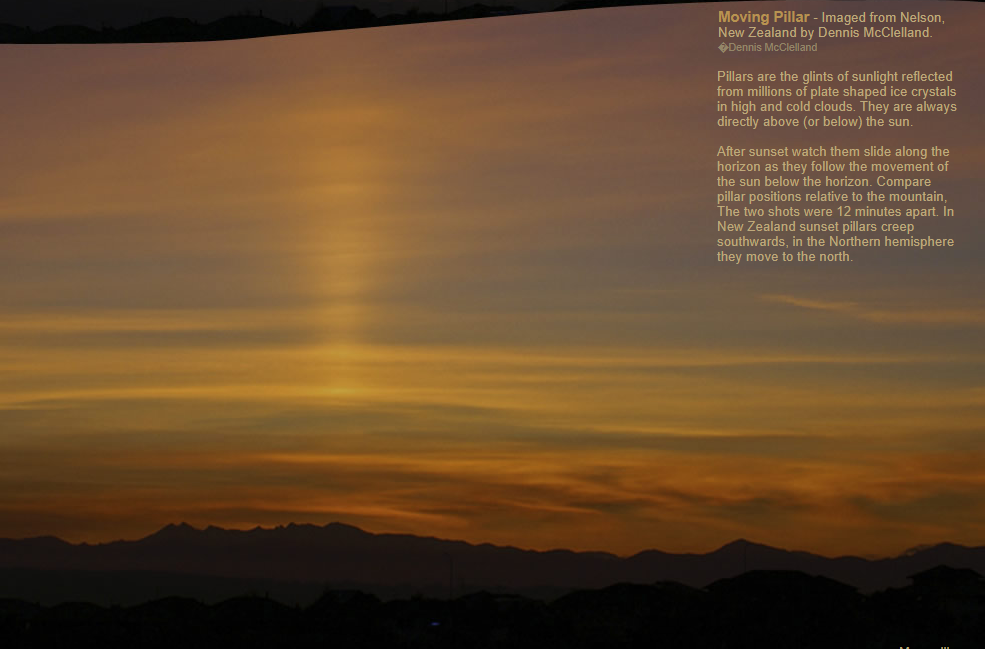Moving Pillar
Moving Pillar: A Fascinating Phenomenon in Atmospheric Optics
Atmospheric optics never fails to amaze us with its array of captivating optical phenomena. One such phenomenon is the "moving pillar," a mesmerizing display of sunlight reflecting off plate-shaped ice crystals in high and cold clouds. These pillars are always positioned directly above or below the sun, creating a stunning visual effect. In this article, we will delve deeper into the intricacies of the moving pillar and explore its behavior in different parts of the world.
As the sun begins to set, observers can witness the moving pillar gracefully sliding along the horizon, following the sun's descent below the horizon. The position of the pillar in relation to the surrounding landscape can change significantly within a short span of time. For instance, comparing two shots taken 12 minutes apart in Nelson, New Zealand, we can observe the pillar's gradual southward movement. Conversely, in the Northern Hemisphere, these pillars tend to shift towards the north.
The moving pillar phenomenon is primarily caused by the interaction between sunlight and ice crystals present in high-altitude clouds. When sunlight passes through these ice crystals, it undergoes refraction and dispersion, resulting in the separation of colors. The plate-shaped ice crystals act as tiny mirrors, reflecting the sunlight back towards the observer and creating the illusion of a vertical pillar of light.
To fully appreciate the beauty of a moving pillar, it is essential to understand the underlying atmospheric conditions that give rise to this optical spectacle. These conditions typically involve the presence of high and cold clouds, which serve as the canvas for these mesmerizing displays. The movement of the pillar is intricately linked to the sun's position below the horizon and the observer's geographical location.
The behavior of moving pillars varies depending on factors such as latitude and time of year. In regions closer to the poles, where the sun remains low on the horizon for extended periods, observers may have the opportunity to witness these pillars for more extended durations. On the other hand, areas closer to the equator may experience shorter-lived moving pillars due to the sun's rapid descent below the horizon.
While the moving pillar phenomenon is most commonly associated with sunsets, it can also occur during sunrise. During these early morning displays, observers can witness the pillars gradually shifting in the opposite direction, adding a touch of magic to the dawn sky. The interplay of light and ice crystals creates a dynamic and ever-changing visual experience that never fails to captivate.
In addition to their aesthetic appeal, moving pillars serve as a reminder of the intricate processes occurring in Earth's atmosphere. The presence of high-altitude clouds and the formation of ice crystals provide valuable insights into atmospheric dynamics and weather patterns. Studying these optical phenomena allows scientists to gain a deeper understanding of the complex interplay between light and matter in our atmosphere.
To capture the beauty of moving pillars, photographers and enthusiasts often venture to locations with optimal atmospheric conditions. Whether it's atop a mountain or near bodies of water, these vantage points offer unobstructed views of the shifting pillars against breathtaking backdrops. The fleeting nature of these phenomena adds an element of excitement and anticipation to each observation, making them a favorite subject for photographers worldwide.
In conclusion, the moving pillar is a captivating atmospheric optics phenomenon that showcases the interplay between sunlight and ice crystals in high-altitude clouds. Its graceful movement along the horizon during sunsets or sunrises provides a mesmerizing spectacle for observers around the world. By understanding the underlying atmospheric conditions and geographical influences, we can appreciate the beauty of these moving pillars and gain valuable insights into Earth's atmospheric dynamics. So next time you find yourself witnessing this ethereal display, take a moment to marvel at the wonders of atmospheric optics unfolding before your eyes.

Moving Pillar - Imaged from Nelson, New Zealand by Dennis McClelland. �Dennis McClelland
Pillars are the glints of sunlight reflected from millions of plate shaped ice crystals in high and cold clouds. They are always directly above (or below) the sun.
After sunset watch them slide along the horizon as they follow the movement of the sun below the horizon. Compare pillar positions relative to the mountain, The two shots were 12 minutes apart. In New Zealand sunset pillars creep southwards, in the Northern hemisphere they move to the north.

Note: this article has been automatically converted from the old site and may not appear as intended. You can find the original article here.
Reference Atmospheric Optics
If you use any of the definitions, information, or data presented on Atmospheric Optics, please copy the link or reference below to properly credit us as the reference source. Thank you!
-
<a href="https://atoptics.co.uk/blog/moving-pillar/">Moving Pillar</a>
-
"Moving Pillar". Atmospheric Optics. Accessed on November 26, 2024. https://atoptics.co.uk/blog/moving-pillar/.
-
"Moving Pillar". Atmospheric Optics, https://atoptics.co.uk/blog/moving-pillar/. Accessed 26 November, 2024
-
Moving Pillar. Atmospheric Optics. Retrieved from https://atoptics.co.uk/blog/moving-pillar/.